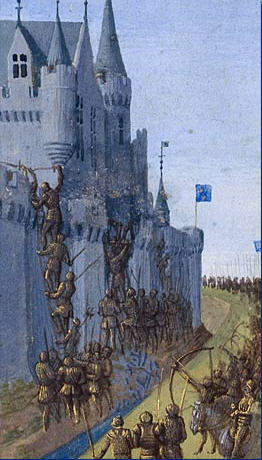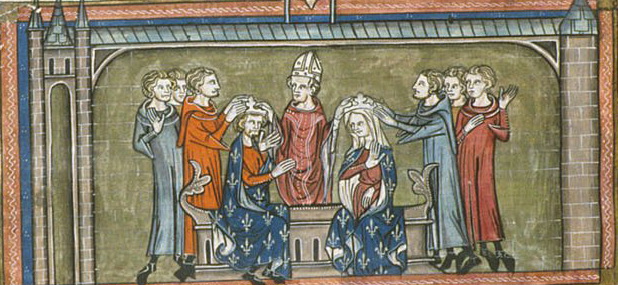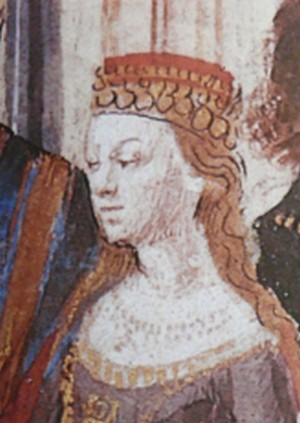|
Hervé IV Of Donzy
Hervé IV of Donzy (1173– 22 January 1222) was a French nobleman and participant in the Fifth Crusade The Fifth Crusade (September 1217 - August 29, 1221) was a campaign in a series of Crusades by Western Europeans to reacquire Jerusalem and the rest of the Holy Land by first conquering Egypt, ruled by the powerful Ayyubid sultanate, led by al- .... By marriage in 1200 to Mahaut de Courtenay (1188–1257), daughter of Peter II of Courtenay, he became Count of Nevers. In a dispute over the château de Gien with Peter of Courtenay, Hervé came to a settlement in 1199, having defeated and captured his overlord Peter at Cosne-sur-Loire. After Peter's death in 1219, he became Count of Auxerre and Tonnerre also; with Philip II, Marquis of Namur and Robert de Courtenay contesting Auxerre. He acquired Liernais also, in 1210. Hervé and his countess were active in developing the Nivernais, his lands around Donzy adjoining the Nivernais and Burgundy (region), Burgundy. In 1209 they f ... [...More Info...] [...Related Items...] OR: [Wikipedia] [Google] [Baidu] |
Fifth Crusade
The Fifth Crusade (September 1217 - August 29, 1221) was a campaign in a series of Crusades by Western Europeans to reacquire Jerusalem and the rest of the Holy Land by first conquering Egypt, ruled by the powerful Ayyubid sultanate, led by al-Adil, brother of Saladin. After the failure of the Fourth Crusade, Innocent III again called for a crusade, and began organizing Crusading armies led by Andrew II of Hungary and Leopold VI of Austria, soon to be joined by John of Brienne, titular King of Jerusalem. An initial campaign in late 1217 in Syria was inconclusive, and Andrew departed. A German army led by cleric Oliver of Paderborn, and a mixed army of Dutch, Flemish and Frisian soldiers led by William I of Holland, then joined the Crusade in Acre, with a goal of first conquering Egypt, viewed as the key to Jerusalem. There, cardinal Pelagius Galvani arrived as papal legate and ''de facto'' leader of the Crusade, supported by John of Brienne and the masters of the Templar ... [...More Info...] [...Related Items...] OR: [Wikipedia] [Google] [Baidu] |
Nièvre
Nièvre () is a department in the Bourgogne-Franche-Comté region, central-east France. Named after the river Nièvre, it had a population of 204,452 in 2019.Populations légales 2019: 58 Nièvre INSEE Its is . Covering an area 6,817 square kilometres (2,632 sq mi), Nièvre is landlocked between six other departments: Yonne to the north, |
Yolande I, Countess Of Nevers
Yolande I, Countess of Nevers (died 1254), was the daughter of Guy II, Count of Saint-Pol and Agnès de Donzy. She was the heiress of her grandmother Matilda I, but died before her. She married Archambaud IX of Bourbon (d. 1249) and had the following children: * Matilda II, Countess of Nevers Matilda II, Countess of Nevers (1234/35–1262), also known as Maud of Dampierre or Mathilda II of Bourbon, was a sovereign Countess of Nevers, Countess of Auxerre, Countess of Tonnerre. Matilda was a daughter of Archambaud IX of Bourbon a ... (d. 1262) * Agnes, Lady of Bourbon (1237 - 7 September 1288) She died in 1254. References * Alice Saunier-Seité, Les Courtenay, Éditions France-Empire, 1998 (ISBN 2-7048-0845-7), p. 93 {{Expand French, Yolande de Châtillon, topic=gov, date=June 2022 1254 deaths 13th-century countesses regnant Counts of Nevers Year of birth unknown 13th-century ladies consort ... [...More Info...] [...Related Items...] OR: [Wikipedia] [Google] [Baidu] |
Guy II, Count Of Saint-Pol
Guy IV (c. 1197 – 1226) of the House of Châtillon was the '' de facto'' count of Saint-Pol as Guy II from 1219/1223 until his death. Life Born around 1197, Guy was the eldest son of Walter III of Châtillon and Elizabeth, heiress of Saint-Pol. Upon his father's death in 1219, he inherited the castle of Montjay-la-Tour and the county of Saint-Pol, although his mother retained the right of residence for life. His younger brother, Hugh, inherited Châtillon, Crécy and the butlership of the county of Champagne. Guy and Hugh consented to their father placing his lands under the guardianship of Philip of Nanteuil, his executor. In a sign of his father's wealth and prestige, Guy made a very advantageous marriage. In 1221, he married Agnès II, Countess of Nevers, daughter of Hervé IV of Donzy, who had been betrothed to Philip, eldest son of the future King Louis VIII, until his premature death in 1218. She was supposed to then marry the future Louis IX, bu ... [...More Info...] [...Related Items...] OR: [Wikipedia] [Google] [Baidu] |
Louis VIII Of France
Louis VIII (5 September 1187 8 November 1226), nicknamed The Lion (), was King of France from 1223 to 1226. As a prince, he invaded Kingdom of England, England on 21 May 1216 and was Excommunication in the Catholic Church, excommunicated by a papal legate on 29 May 1216. On 2 June 1216, Louis was proclaimed "King of England" by rebellious barons in London, though never crowned. With the assistance of allies in England and Scotland he gained control of approximately one third of the English kingdom and part of Southern Wales. He was eventually defeated by English loyalists and those barons who swapped sides following the death of King John of England, King John. After the Treaty of Lambeth, he was paid 10,000 mark (currency), marks, pledged never to invade England again, and was absolved of his excommunication. As prince and fulfilling his father's crusading vow, Louis led forces during the Albigensian Crusade in support of Simon de Montfort, 5th Earl of Leicester, Simon de Mo ... [...More Info...] [...Related Items...] OR: [Wikipedia] [Google] [Baidu] |
Agnès II, Countess Of Nevers
Agnes II of Nevers or Agnes II of Donzy, (born around 1205 and died in 1225), was Countess consort of Guy II of Saint-Pol from 1221 to 1225. On the death of her father (1222), her mother Mathilde de Courtenay assigned her the three counties for which she was responsible, Nevers, Auxerre and Tonnerre, from 1222 to 1225. Biography Agnes was the daughter of Hervé IV, Baron of Donzy, and Mathilde de Courtenay. Her mother was the only child from the first marriage of Peter II of Courtenay and Countess Agnes I of Nevers, of whom she was the heiress. The marriage of Agnes de Donzy's parents was the consequence of a peace treaty: during a conflict, Hervé of Donzy took Peter II of Courtenay prisoner, and he had to grant Donzy the hand of his daughter and ceded him the county of Nevers. Marriages and descendants Agnes became heiress to the counties of Nevers, Auxerre and Tonnerre after the death of her brother William (around 1207-1214). On 8 September 1217, she was married to ... [...More Info...] [...Related Items...] OR: [Wikipedia] [Google] [Baidu] |
Philip II Of France
Philip II (21 August 1165 – 14 July 1223), also known as Philip Augustus (), was King of France from 1180 to 1223. His predecessors had been known as kings of the Franks (Latin: ''rex Francorum''), but from 1190 onward, Philip became the first French monarch to style himself "King of France" (''rex Francie''). The son of King Louis VII and his third wife, Adela of Champagne, he was originally nicknamed () because he was a first son and born late in his father's life. Philip was given the epithet "Augustus" by the chronicler Rigord for having extended the crown lands of France so remarkably. After decades of conflicts with the House of Plantagenet, Philip succeeded in putting an end to the Angevin Empire by defeating a coalition of his rivals at the Battle of Bouvines in 1214. This victory would have a lasting impact on western European politics: the authority of the French king became unchallenged, while John, King of England, was forced by his barons to assent to Magna C ... [...More Info...] [...Related Items...] OR: [Wikipedia] [Google] [Baidu] |
John, King Of England
John (24 December 1166 – 19 October 1216) was King of England from 1199 until his death in 1216. He lost the Duchy of Normandy and most of his other French lands to King Philip II of France, resulting in the collapse of the Angevin Empire and contributing to the subsequent growth in power of the French Capetian dynasty during the 13th century. The First Barons' War, baronial revolt at the end of John's reign led to the sealing of Magna Carta, a document considered a foundational milestone in English and later British constitution of the United Kingdom, constitutional history. John was the youngest son of King Henry II of England and Duchess Eleanor of Aquitaine. He was nicknamed John Lackland () because, as a younger son, he was not expected to inherit significant lands. He became Henry's favourite child following the failed revolt of 1173–1174 by his brothers Henry the Young King, Richard I of England, Richard, and Geoffrey II, Duke of Brittany, Geoffrey against their ... [...More Info...] [...Related Items...] OR: [Wikipedia] [Google] [Baidu] |
Battle Of Bouvines
The Battle of Bouvines took place on 27 July 1214 near the town of Bouvines in the County of Flanders. It was the concluding battle of the Anglo-French War (1213–14), Anglo-French War of 1213–1214. Although estimates on the number of troops vary considerably among modern historians, at Bouvines, a French army commanded by King Philip II of France, Philip Augustus routed a larger allied army led by Holy Roman Emperor Otto IV, Holy Roman Emperor, Otto IV in one of the rare pitched battles of the High Middle Ages and one of the most decisive Middle Ages, medieval engagements. In early 1214, a coalition was assembled against King Philip Augustus of France, consisting of Otto IV, King John of England, Count Ferdinand, Prince of Portugal, Ferrand of Flanders, Count Renaud de Dammartin, Renaud of Boulogne, Duke Henry I of Brabant, Count William I of Holland, Duke Theobald I, Duke of Lorraine, Theobald I of Lorraine, and Duke Henry III of Limburg. Its objective was to reverse the ... [...More Info...] [...Related Items...] OR: [Wikipedia] [Google] [Baidu] |
Albigensian Crusade
The Albigensian Crusade (), also known as the Cathar Crusade (1209–1229), was a military and ideological campaign initiated by Pope Innocent III to eliminate Catharism in Languedoc, what is now southern France. The Crusade was prosecuted primarily by the French crown and promptly took on a political aspect. It resulted in the significant reduction of practicing Cathars and a realignment of the County of Toulouse with the French crown. The distinct regional culture of Languedoc was also diminished. The Cathars originated from an anti-materialist reform movement within the Bogomil churches of the Balkans calling for what they saw as a return to the Christian message of perfection, poverty and preaching, combined with a rejection of the physical. The reforms were a reaction against the often perceived scandalous and dissolute lifestyles of the Catholic clergy. Their theology, Gnostic in many ways, was basically dualistic cosmology, dualist. Several of their practices, especially ... [...More Info...] [...Related Items...] OR: [Wikipedia] [Google] [Baidu] |
Touraine
Touraine (; ) is one of the traditional provinces of France. Its capital was Tours. During the political reorganization of French territory in 1790, Touraine was divided between the departments of Indre-et-Loire, :Loir-et-Cher, Indre and Vienne. Geography Traversed by the river Loire and its tributaries the Cher, the Indre and the Vienne, Touraine makes up a part of the western Paris Basin. It is well known for its viticulture. The TGV high-speed train system, which connects Tours with Paris (200 kilometers away) in just over an hour, has made Touraine a place of residence for people who work in the French capital but seek a different quality of life. History Touraine takes its name from a Celtic tribe called the Turones, who inhabited the region about two thousand years ago. In 1044, the control of Touraine was given to the Angevins, who (as the House of Plantagenet) became kings of England in 1154, the castle of Chinon being their greatest stronghold. In 1205, Phil ... [...More Info...] [...Related Items...] OR: [Wikipedia] [Google] [Baidu] |
Poitou
Poitou ( , , ; ; Poitevin: ''Poetou'') was a province of west-central France whose capital city was Poitiers. Both Poitou and Poitiers are named after the Pictones Gallic tribe. Geography The main historical cities are Poitiers (historical capital city), Châtellerault (France's kings' establishment in Poitou), Niort, La Roche-sur-Yon, Thouars, and Parthenay. History Historically Poitou was ruled by the count of Poitou, a continuous line of which can be traced back to an appointment of Charlemagne in 778. A marshland called the Poitevin Marsh (French '' Marais Poitevin'') is located along the Gulf of Poitou, on the west coast of France, just north of La Rochelle and west of Niort. At the conclusion of the Battle of Taillebourg in the Saintonge War, which was decisively won by the French, King Henry III of England recognized his loss of continental Plantagenet territory to France. This was ratified by the Treaty of Paris of 1259, by which King Louis annexed Norm ... [...More Info...] [...Related Items...] OR: [Wikipedia] [Google] [Baidu] |





